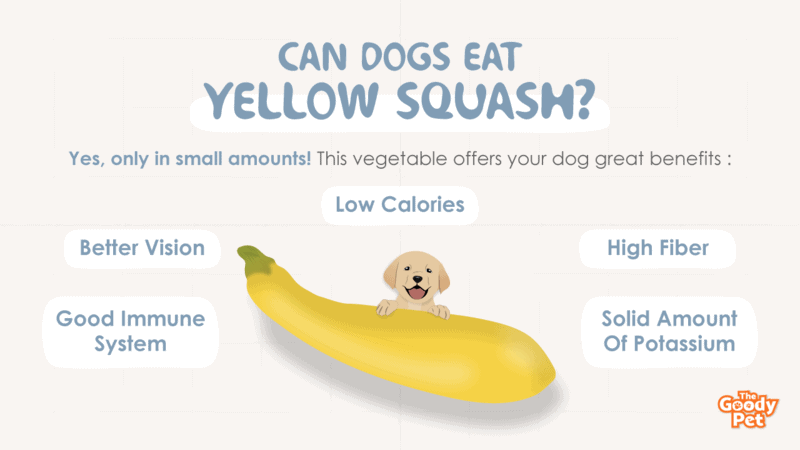Have you been hearing all about how amazing yellow squash is for dogs, but you aren’t sure if you should include it in your pup’s diet or not? Well, let’s reassure you.
Dogs can have yellow squash to promote a healthy nervous system and muscle function. This vegetable also helps with bone strength, energy production, and proteins. Plus, it contains phosphorus, which contributes significantly to better skeletal structure and teeth.
Moreover, yellow squash belongs to the Cucurbitaceae family and is a type of fruit that your dog can enjoy. Specifically, the yellow squash is slightly sweeter than zucchini and has cream-colored flesh inside.
This healthy vegetable contains several powerful antioxidants, including chlorogenic acid and caffeic acid. These antioxidant properties help with cancer prevention in dogs.
There are way more benefits of yellow squash along with some drawbacks. We will hit upon these topics and tell you how to cook this veggie in the right way for your dog. So, hold on tight because we are going to get started!
What Happens If Your Dog Eats Yellow Squash?
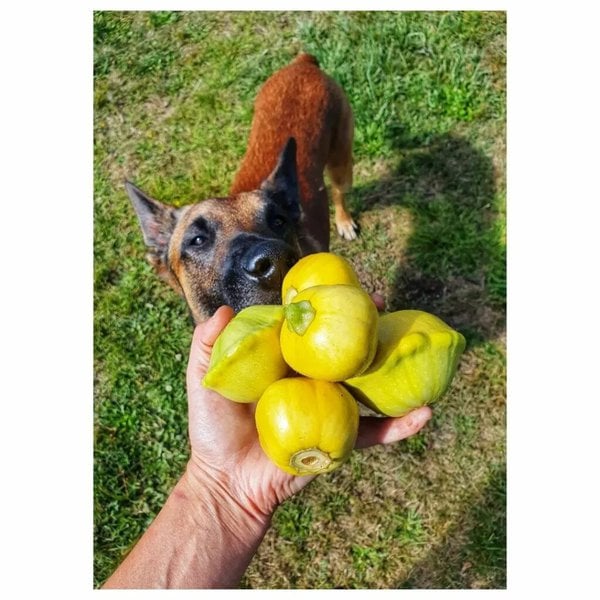
If your dog eats yellow squash, it will improve its digestive system and weight management.
It is because yellow squash is an excellent source of dietary fiber in dogs, containing between 5% to 6% fiber. In addition to being tasty, it also offers your dog great benefits such as the following:
Low Calories
The yellow squash is low in calories and can encourage a healthy weight, especially with high-fiber veggies such as sweet potatoes.
Better Vision
Yellow squash is an excellent source of vitamins A and C, which promote better eyesight. It is also rich in lutein and zeaxanthin, two carotenoids that protect the eyes from oxidative damage and encourage healthy vision.
Vitamins And Nutrients
Yellow squash is rich in vitamins and nutrients. It also offers over 10% of the daily value for dietary fiber, which helps maintain healthy digestion.
Yellow squash has plenty of vitamin A for eyesight, vitamin K to help with blood clotting, vitamin C for immune function and wound healing, and vitamin B6 for a healthy metabolism.
Yellow squash is rich in minerals such as calcium and magnesium. It also contains phosphorus, manganese, copper, and iron, which are beneficial to health and help keep your pup strong.
Plus, it has a high percentage of water, which decreases strain on the kidneys due to its diuretic properties.
High Fiber
The yellow squash is a healthy option for dogs as it helps maintain their digestion. It also prevents diseases like colon cancer, heart disease, or diabetes.
It is believed that yellow squash is suitable if your dog suffers from the following diseases.
- Diverticulitis
- Diarrhea
- Inflammatory bowels
Good Immune System
In addition to being a healthy snack for your pup, yellow squash is also an excellent source of beta-carotene. This nutrient helps strengthen dogs’ immune systems while encouraging quick recovery from illness.
Solid Amount Of Potassium
Dogs need a lot of potassium to keep their hearts healthy and strong. Also, if your pup has been having trouble with muscle cramps, you should include yellow squash in their diet. This veggie is high in potassium, so your dog can stay active without feeling pain.
How Do You Cook Yellow Squash For Your Dog?
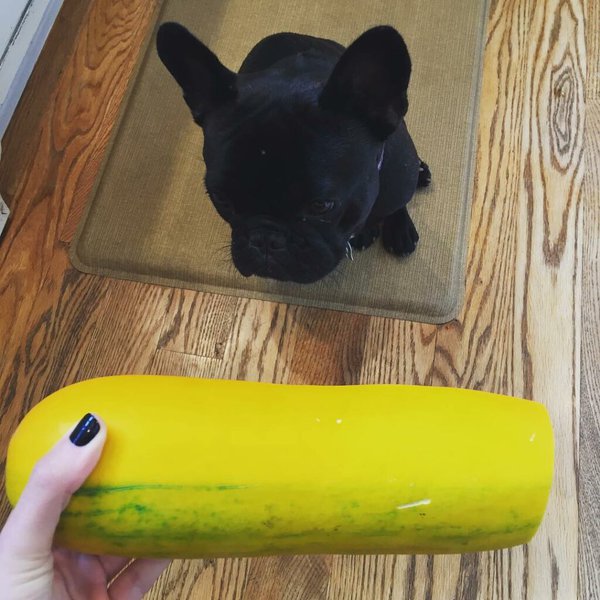
Simply cutting the rind off the yellow squash, cooking it properly, then mixing it with your dog’s favorite food should be enough to get it eaten with no issues.
Even though the rind on yellow squash contains most of its nutrients, removing the skin is vital due to its bitter taste that can turn your dog away from eating it.
In addition, yellow squash is extremely easy to prepare as a vegetable for your dog. Just follow the recipe below, and you will get a tasty meal for your pup.
Quick And Easy Recipe
Yellow squash is extremely easy to prepare as a vegetable for your dog.
Ingredients
- One yellow squash
- Olive oil
Directions
- Simply slice the yellow squash in half and remove the seeds from the center of each piece.
- Next, place both halves facedown on a baking sheet and drizzle olive oil over it.
- Bake at 350 °F for 30 to 40 minutes or until the flesh is soft when pricked with a fork.
- Yellow squash can be served hot directly from the oven. Plus, it makes an excellent addition to any of your dog’s meals throughout the week.
Yellow squash can be boiled or roasted, but you should not give it raw as this can cause stomach upset. You can also add yellow squash to your dog’s diet by using it as a replacement for pasta. Plus, boiled and drained yellow squash can easily replace one cup of cooked pasta.
Recipe For Cooking Yellow Squash In Bulk
This recipe will help you come up with 15 servings, which is excellent if your puppy’s buddies are coming over. If not, then you can simply store it for later.
Ingredients
- One yellow squash
- 2 cups of water
- 5 lbs of dog food
Directions
- Preheat the oven to 400 °F.
- Wash and cut the yellow squash into cubes, put in a casserole dish or baking pan with water, and mix thoroughly.
- Bake until all the water has evaporated (about 40 minutes), then let the mixture sit for about 10 minutes.
- Add dog food, mix thoroughly and serve.
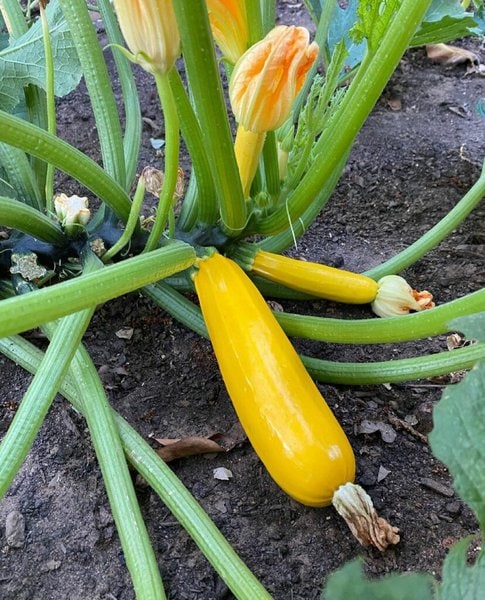
How Much Yellow Squash Can A Dog Eat?
You might be wondering how much yellow squash is too much. It’s a valid question – after all, not all vegetables are considered healthy for dogs. Let’s take a look at when and how much yellow squash you can feed your pup.
Duration Of Feeding
Providing yellow squash to your dog should be limited to two or three days at the most, especially if it’s not part of their regular diet. If your dog has a severe allergy to certain foods, check with your vet before introducing anything new.
Amount To Feed
So, how much yellow squash can a dog eat? The amount depends on its size and whether or not it is part of a balanced diet. Avoid feeding dogs high amounts of orange-colored or yellow-colored fruits and vegetables, as they contain carotene, which can be harmful.
It may be best to introduce yellow squash into your dog’s diet gradually and in small amounts to check for any adverse effects that it may have on their digestive system.
Moreover, middle-aged dogs might have more of a challenge digesting yellow squash than younger pups do. So, it is better to feed older dogs yellow squash cut into tiny cubes.
What Happens If My Dog Eats Too Much Yellow Squash?
A dog overeating yellow squash will experience intestinal upset, including vomiting and diarrhea. The good news is that the effects of eating large quantities of yellow squash are not severe.
Yellow squash contains a high amount of phosphorus which needs to be considered when feeding it to dogs with kidney problems.
You should also note that this vegetable is part of the nightshade family. As a result, it can cause stomach upset or diarrhea if given in large quantities, as with most vegetables.
Here are some of the other side effects of feeding too much yellow squash to your dog.
Gastric Dilatation
If your dog eats yellow squash too much, too fast, or ingests, the yellow squash seeds can lead to intestinal discomfort similar to an allergic reaction.
This type of stomach upset in dogs is typically referred to as gastric dilatation and volvulus. The abdomen becomes stretched out of shape, leading to a life-threatening condition called bloat. This condition will resolve itself as long as the yellow squash is digested without much difficulty.
GI Tract Obstruction
Suppose your dog eats a considerable amount of yellow squash in a short period. In that case, your pup may exhibit signs indicating an obstruction in its GI tract, including vomiting blood or passing black stools.
If you suspect that your dog has eaten a large amount of yellow squash and is experiencing more than just gastrointestinal upset, it is crucial to seek veterinary assistance immediately.
This condition can be pretty serious if not treated promptly. Treatments include surgery to remove the obstruction caused by vegetables like yellow squash. Still, when fed occasionally or in small amounts, yellow squash is an excellent addition to a canine’s diet.
Hypotension
The American Heart Association lists low blood pressure as one of the many symptoms that dogs can exhibit in cases of hypotension.
As yellow squash has higher water content, feeding your pup a high amount of it can lead to hypertension. When a dog’s blood pressure falls, it may become weak or disoriented. They could have trouble breathing, experience seizures, or collapse.
Hypoglycemia
Dog’s blood sugar levels fall low, spiking the brain’s glucose level requirements, causing confusion, seizures, and even coma. Symptoms vary by breed type.
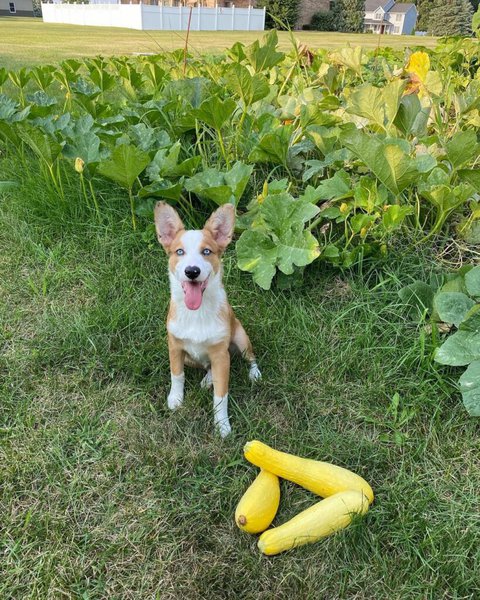
Allergic Reactions
If your dog is allergic to yellow squash, the canine’s immune system will identify a protein in it as foreign and attack it. These reactions can be mild (redness and itching) or severe (anaphylaxis).
Digestive Problems
If your dog overeats yellow squash, it may experience diarrhea, vomiting, or constipation. So, it’s essential to keep an eye on the amount your dog eats. The reason is that overeating or digesting large amounts can create various intestinal issues.
Consult your vet for more information regarding the symptoms displayed in your dog.

